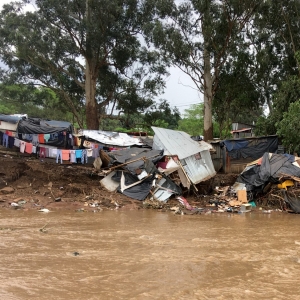Federal Water Tap, April 25: Colorado River States, Interior Near Completion of 2022 Drought Response Plan
The Rundown
- Colorado River basin states approve a plan to release more water from high-elevation reservoirs into Lake Powell, to prop up the ailing reservoir.
- The White House restores a more expansive definition of environmental impacts for federal reviews.
- The OMB releases guidelines for using American-made materials in federal infrastructure bill projects.
- The FDA lowers the fluoride limit for bottled water.
- The EPA holds a public meeting to discuss revisions to water quality reports mailed to utility customers.
- The USGS publishes a model of groundwater flow in the Grand Canyon, part of its attempt to understand the potential effects of uranium mining in the area.
- An EPA report highlights innovative uses of the state revolving funds.
And lastly, a Great Lakes water quality group releases a report to guide decommissioning of nuclear facilities in the basin.
“It used to be — if you’d look, from the Atlantic Coast almost to the Mississippi River was heavy forests, and we took it all down over those years.” — President Joe Biden, in remarks announcing an executive order to catalog old-growth forests on federally managed public lands and develop plans for planting more trees.
By the Numbers
0.7 Milligrams per Liter: New limit on fluoride in bottled water. The Food and Drug Administration, which regulates packaged drinks, lowered the current standard that ranges between 0.8 and 1.7 milligrams per liter. The FDA said the new standard balances cavity prevention and excess fluoride consumption.
$420 Million: Second round of funding announced by the Natural Resources Conservation Service for watershed restoration, flood prevention, and dam repairs. The funds are part of the $918 million that NRCS was allocated under the federal infrastructure bill.
News Briefs
Colorado River Drought Plan
Last week, water officials from the Upper Colorado River basin approved a drought response plan for 2022 that is aimed at keeping water levels at Lake Powell from dropping so low that the reservoir can no longer generate hydropower.
The plan now goes to the secretary of the Interior for final approval. That is expected to happen in the first days of May, Amee Andreason, a Bureau of Reclamation spokesperson told Circle of Blue.
A key element of the plan is to increase water releases from reservoirs above Lake Powell. About 500,000 acre-feet would be delivered from Flaming Gorge. Water also could be released from the smaller Blue Mesa and Navajo reservoirs, depending on conditions.
The plan — approved by officials in Colorado, New Mexico, Utah, and Wyoming, as well as the Upper Colorado River Commission — is separate from Interior’s move to consider holding back an additional 480,000 acre-feet in Lake Powell this year.
Using American-Made Products to Rebuild America’s Infrastructure
The Office of Management and Budget released guidelines for using American-made products in projects funded by the federal infrastructure bill.
The Build America, Buy America provision is strict. It requires all “iron, steel, manufactured products, and construction materials” to be produced in the United States. The guidelines define these terms. For instance, a manufactured product must have at least 55 percent of the cost of its components come from domestic mining, production, or manufacturing.
This matters for water systems, which will be doing a lot of building in the next five years thanks to billions of dollars made available in the act. What they worry about is whether enough American-made products will be available to do all the constructing.
The guidelines address those fears. It allows for waivers if American-made materials are not available, or if they would increase the overall project cost by more than 25 percent, or if they are “inconsistent with the public interest.”
The EPA is hosting a webinar on April 28 for water sector groups to discuss what the provisions mean. Register here.
White House Reinstates Environmental Review Standards
The Biden administration is once again allowing federal environmental reviews to assess impacts that extend beyond the immediate project — those “indirect” and “cumulative” impacts such as greenhouse gas emissions and a community’s aggregate pollution burden.
The action, the first of two phases to address the National Environmental Policy Act, undoes changes to NEPA made by Biden’s predecessor, Donald Trump.
The Trump administration rules, the first major changes to the act in four decades, were an attempt to narrow the amount of information under considering, argues Dan Farber, a professor at Berkeley Law. “Their goal was clearly to prevent consideration of climate change.”
Why restore the assessment of cumulative impacts? The Council on Environmental Quality, which oversees NEPA, noted in its justification that it “does not consider such harms to be inconsequential or irrelevant, but rather critical to sound agency decision making.”
Environmental groups, meanwhile, told E&E News that they plan to continue legal challenges to the Trump rules, in pursuit of a few restoration of the 1978 guidelines.
Studies and Reports
Nuclear Decommissioning along the Great Lakes
An expert panel offered recommendations for decommissioning and monitoring the 38 nuclear power reactors in the Great Lakes region. The panel recommends that the U.S. and Canada not approve any new interim or permanent nuclear waste storage facilities near the Great Lakes shores or tributaries.
The report is from the Great Lakes Water Quality Board, a subgroup of the International Joint Commission, the binational agency that monitors Great Lakes water quality.
The recommendations span four broad categories: long-term monitoring, waste storage, transport of spent nuclear fuel, and public engagement.
Groundwater in the Grand Canyon
The U.S. Geological Survey published a report modeling the dynamics of a somewhat mysterious topic: how groundwater flows in the Grand Canyon region.
It is not well understood how water moves through the Kaibab and Coconino plateaus to reach the canyon’s springs and creek. These are important water sources in an arid region. They supply the tourist infrastructure (hotels, restaurants, visitor centers) on the South Rim and the people living in Supai village, home to the Havasupai Tribe.
In 2012, the federal government prohibited new uranium mining claims for 20 years in a 1 million acre expanse around the Grand Canyon. The action was due to uncertainty about impacts. The USGS report is part of a larger effort to understand the potential consequences of uranium mining on the area’s groundwater.
Best Practices for Drinking Water Funding
As a learning tool, the EPA published a report that highlights innovative and successful ways that states have used the Drinking Water State Revolving Fund to finance water infrastructure.
Those innovations, for instance, include wealthier Camden County, New Jersey, applying for loans on behalf of a poorer neighbor, Camden City.
Wise use of the revolving funds is important because they are the primary vehicle for federal infrastructure bill funding.
On the Radar
Water Week
It’s Water Week in D.C., when water leaders from around the country convene in the nation’s capital to discuss policy priorities with lawmakers and government officials.
A list of event is here.
Consumer Confidence Report Revisions
At a public meeting on April 26, the EPA will take comments on ways to update water quality reports mailed to utility costumers so that the information is more understandable.
Register here for the meeting, which will be held from 2 p.m. to 5 p.m. Eastern.
EPA Advisory Board Charter Renewal
The EPA is extending for two years the charter of the Environmental Financial Advisory Board, the expert panel that advises the agency on the question ‘How to pay for it?’
2023 Budget Hearings
Cabinet secretaries will be on Capitol Hill to justify their funding requests to lawmakers, who have the power to approve or deny.
House Appropriations subcommittees will discuss the Army Corps of Engineers/Bureau of Reclamation budget on April 27, the Interior budget and the USDA budget on April 28, and the EPA budget on April 29.
Federal Water Tap is a weekly digest spotting trends in U.S. government water policy. To get more water news, follow Circle of Blue on Twitter and sign up for our newsletter.
Brett writes about agriculture, energy, infrastructure, and the politics and economics of water in the United States. He also writes the Federal Water Tap, Circle of Blue’s weekly digest of U.S. government water news. He is the winner of two Society of Environmental Journalists reporting awards, one of the top honors in American environmental journalism: first place for explanatory reporting for a series on septic system pollution in the United States(2016) and third place for beat reporting in a small market (2014). He received the Sierra Club’s Distinguished Service Award in 2018. Brett lives in Seattle, where he hikes the mountains and bakes pies. Contact Brett Walton







Leave a Reply
Want to join the discussion?Feel free to contribute!